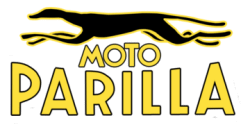


Parilla High-cams - What to look for
So you found a Parilla high-cam now what? More often than not, it will be a project with something wrong with it. There is usually a reason why it was parked behind a barn and under a tarp for years. Many projects go through a rather predictable history. The first owner bought it new, rode it for a few years and parked it. The bike usually has about 5,000 miles on the clock about this time. Next is the downward spiral of owners, or owner's kids who try to get it back on the street. There is no real (or real easy) shop manual for this motorcycle, so the bike goes through the home repair & "customizing" phase. Parts go missing, sheetmetal gets damaged and then there is the backyard repairs that make the bike ultimately unrideable. After that, they go through the hibernation stage where they just sit and rust. Water is the enemy and high-cam motors can't cope with moisture.
What to check for in a project
|
|
First, pull the bike out of whatever hiding place it has been in for the last several decades and see what you have. Sure it's dirty, but that's ok. Looks like you have a 250cc Trailmaster or a late model Tourist and it's mostly complete. The mileage is just over 5,000. |
|
Serial numbers: Serial numbers tell you a lot, but not everything. For 50's high-cams, the numbers will tell you if it is a touring bike or a GS and a good idea at what year it was built. On 250 bikes, the numbers will tell you if it is a GS, Wildcat scrambler, or a Tourist/Trailmaster model. The frame number is located in front of the tank. This number is 250-828. #828 is high up on the #250-xxx range, so it looks like a 1964-66 model. The gas tank shape also says it's probably a late model Tourist. |
|
|
|
Motor number: The engine number is located near the top motor mount and should match the frame number. Some don't, but it all depends on the application. A Touring motor in a GS frame is not good. A GS motor in a Touring frame? That would be considered an owner installed upgrade. No number stamped on the motor? That would be a 250 with one of Cosmo's surplus motors. A lot of 250 bikes used the unmarked motors and they were also sold separately as a replacement. |
|
Check the motor: The clutch cover says it's a 250. You can check out the differences between engines on our motors page if you are not sure. One sign that it has not been tampered with is the intact rubber pushrod cover clamps. These items get lost pretty easily and are impossible to replace, so save them. |
|
|
|
Inside look #1: Most of the value in a high-cam is the motor. Time to get a look inside and see if you have hit the jackpot. First unscrew the oil dipstick. The black knob might be in the front or in the back of the motor. Do not use any tools on this part or you will destroy the plastic. Lucky you, this dipstick is not rusty and has oil on it. |
|
Inside look # 2: Time to get a better look inside. The clutch cover is the best way to check. Use a 5mm hex wrench and take care not to strip the bolt heads. The bolts are different lengths, so don't mix them up. The cover will need to be pried off with some kind of sharp knife. Be careful, the engine case damages easily. Don't forget to have something under the motor to catch the oil that will pour out. |
|
|
|
The clutch: Oh Boy, this is good! Get a look at the undamaged clutch bolt. Looks like nobody has been inside this motor and screwed it up. Also, there is no rust to be found inside which is a huge plus. |
|
Gear drive? Find out: Almost all high-cams are chain drive, but you might get lucky and end up with a gear drive motor. Take a flashlight and shine it up in the 10 o'clock position inside the clutch cover. If you see part of a chain, well you have a chain drive. This engine has a chain driven camshaft. |
|
|
|
Original?: Has the bike been modified, or original? One sign is that it's has been untouched is the original metal wire tie downs are still here. More often than not, these items are usually replaced with plastic, since the metal ones rust easily. Another bonus is that the alloy toolbox is there with it's Parilla dog sidecovers. A very hard to replace item. The toolbox knob is missing, but there are replacements still available. |
|
Wheels: This bike at least rolls, which is good. Frozen hubs are hard to replace. Don't bother trying to restore the rusty steel rims. They are easily replaceable with better quality rims. The Parilla front fender is a little more deluxe than other Italian company fenders, so this is a big plus that is it still on the bike. The front forks use to be considered below average, but you can't find them any more, so they are becoming scarce. Early style Parilla forks from the mid-50's are very different from the late style and there are no replacement parts available anywhere, so look for a bike with a complete set. |
|